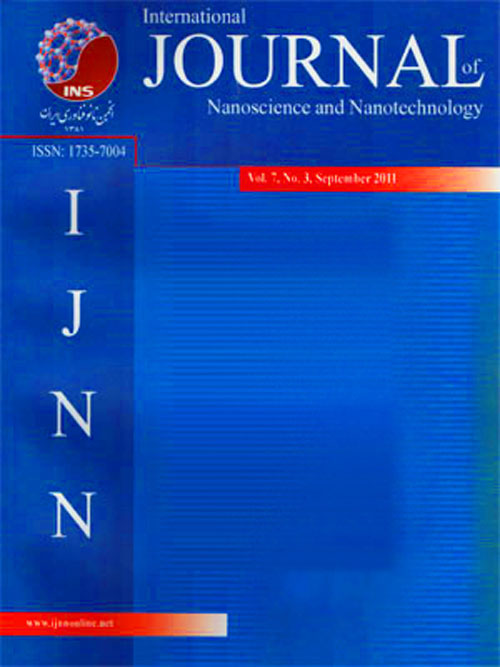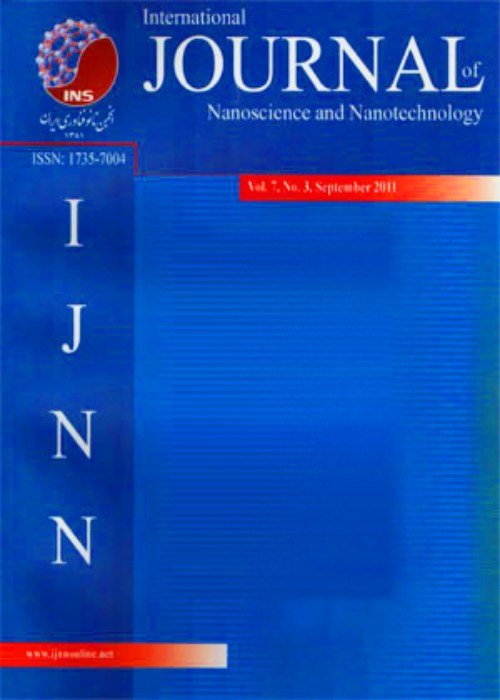فهرست مطالب

International Journal Of Nanoscience and Nanotechnology
Volume:12 Issue: 1, Winter 2016
- تاریخ انتشار: 1395/02/07
- تعداد عناوین: 7
-
-
Pages 1-5The paper reports the preparation and photocatalytic activity of ZnO doped SnO2 nanoparticles. These nanoparticles were synthesized by hydrothermal method. The products were characterized by X-ray diffraction (XRD) and scanning electron microscopy (SEM). Their grain sizes are about 50-100 nm. The characterization results revealed that the synthesized nanoparticles possess just crystal phases of tetragonal rutile phase of SnO2 with high quantity and good crystallinity. The photocatalytic activity of this material was investigated for congo red removal from aqueous solution under UV light irradiation. It was shown that the use of ZnO doped SnO2 nanoparticle as a photocatalyst has a better photocatalytic activity for degradation of congo red than SnO2 or TiO2 (anatase, particle size: 30 nm) alone. This good performance can be attributed to more charge separation; then the recombination of electrons and holes in ZnO doped SnO2 nanoparticle is greatly suppressed. This is the reason that the ZnO doped SnO2 nanoparticles possessed both higher photocatalytic oxidation and reduction activities than those of TiO2 or SnO2.Keywords: Hydrothermal, Nanoparticle, Photocatalyst, SEM, ZnO doped SnO2
-
Pages 7-18In this work, the effect of annealing temperature on the microstructure, morphology, and optical properties of Cu-doped nanostructured MnO2 thin films were studied. The thin films were prepared by sol-gel spin-coating technique on glass substrates and annealed in the air ambient at 300, 350, 400 and 450 °C temperatures. The structural, morphological and optical properties of the annealed MnO2: Cu films have been studied by X-ray diffraction (XRD), Field Emission Scanning Electron Microscopy (FESEM), UV-Vis spectroscopy and Fourier Transform Infrared (FTIR) Spectroscopy. The XRD patterns showed that the crystallinity of the films was decreased with increasing annealing temperature. FE-SEM images of films showed that an increase in annealing temperature affected the densification of the films and increased the porosity of the films. For the first time, the thickness, optical constants and complex dielectric function of MnO2: Cu thin films were determined by simulating transmission spectra using Forouhi-Bloomer model in the optimization process. The optical band gap of MnO2: Cu thin films were enhanced with increasing annealing temperature from 1.86 eV to 1.98 eV. The presence of Mn-O and other bonds in the films were confirmed by FTIR spectroscopy.Keywords: Manganese oxide, Doping, Nanostructured thin film, Optical properties, Sol, gel
-
Pages 19-26In this work the effect of Nano-sized Fe2O3 on microstructure and hydration resistance of MgO-CaO refractories with 35 wt% CaO was investigated. MgO-CaO refractories with 35 wt% CaO content was prepared by using dolomite and magnesite calcined as starting materials and Nano-sized Fe2O3 (2,4, 6 and 8 wt%) as an additive. Samples were pressed into briquettes at a pressure of 90 MPa. Briquettes after drying at 110 oC for 24 hours were sintered at 1650 oC for 3 hours. Hydration resistance was measured at 25 oC in 95% relative humidity through the weight gain after 72 hours. According to the results, it is observed that when the amount of Nano-sizedFe2O3 added increased to 8 wt% the bulk density increased to 3.14 gr/cm3 and apparent porosity decreased to 8.20%. For the sample without addition, the mass gain after 72 hours was 1.76, which sharply decreased to 1.27 with increasing the amount of Nano-sized Fe2O3. With the addition of Nano-sized Fe2O3, bulk density and hydration resistance of the samples increased while apparent porosity decreased. Densification of MgO-CaO refractories was promoted to increase of Nano-sized Fe2O3 content. Nano-sized Fe2O3 addition led to formation of low melting phases such as C2F (2CaO.Fe2O3), CF (CaO.Fe2O3) and C3A (3CaO.Al2O3). The formation of this low melting point phases surrounding the CaO and MgO grain and grain boundaries and promoted densification of MgO-CaO refractories. The nature of Nano-sized Fe2O3 promoting densification is increasing the liquid phase sintering.Keywords: Hydration resistance, Densification, Refractory, Nano, sized Fe2O3
-
Pages 27-36During past decade the AFM based nanomanipulation has been focus of attention as the promising nano fabrication approach. The main challenge in this process is the real-time monitoring. Consequently, the dynamic models have been proposed as a solution to the existing challenge. In the modeling approach the magnitudes of the forces are proportional to the stiffness coefficients of cantilevers. The precise calculation of these coefficients has been introduced in numerous works. The proposed stiffness coefficients for the V-shaped cantilevers fail to present in all commercial cantilever geometry. The geometrical deviation has a considerable impact on the magnitude of stiffness coefficients. Therefore, in this paper the existing model has been modified to include the commercial cantilever and take into account the effect of geometry variation. FEM simulation has been used to investigate the effect of geometry change and the results of these simulations have been exerted to the model which resulted in proposed comprehensive model. The proposed new stiffness model covers a wide range of commercial V-shape cantilevers and makes the process more practical.Keywords: Atomic force microscope, V, shaped cantilever, stiffness coefficients
-
Pages 37-43In this work polyaniline nanocomposites were synthesized in aqueous media by using ammonium proxy disulfat (APS) (10g/l) as an oxidant in the presence of hydroxy propyl cellulose (HPC) (2,5,10 g/l) as a surfactant, poly (vinyl chloride) (10,30 g/l) as an additive and sulfuric acid (H2SO4). The effects of concentration of surfactant and additive on morphology have been investigated. The characteristics of the products, such as morphology and molecular structure, were investigated. It was found that the concentrations of surfactant and additive have considerable effects on the particle size and morphology of the resulting product. The results indicate that small and spherical nanoparticles can be obtained using HPC (10 g/l). Also, the chemical structure of products was determined by fourier transform infrared spectroscopy (FTIR). The results indicated that the intensities of the peaks were dependent on the concentration of APS, HPC and PVC. FTIR spectra showed that HPC and PVC particles were available in the products.Keywords: Additive, Chemical structure, morphology, Nanocomposite, Polyaniline, Surfactant
-
Pages 45-53In this paper, we have studied the strain, band-edge, and energy levels of cubic InGaAs quantum dots (QDs) surrounded by GaAs. It is shown that overall strain value is larger in InGaAs-GaAs interfaces, as well as in smaller QDs. Also, it is proved that conduction and valence band-edges and electron-hole levels are size dependent; larger QD sizes appeared to result in the lower recombination energies. Moreover, more number of energy levels separate from the continuum states of bulk GaAs and come down into the QD separate levels. In addition, we show that change of band gap and energy level by size is not linear, i.e., band gap and energy level in smaller QDs are more sensitive to QD size. Our results coincide with former similar researches.Keywords: Band, edge, Engineering energy levels, QD laser, Quantum dot size, Strain PACS numbers: 73.63.Kv, 85.35.Be, 42.55.Px
-
Pages 55-69Quantum-dot Cellular Automata (QCA) technology is a solution for implementation of the nanometer sized circuits and it can be a suitable replacement for CMOS. Similar to CMOS technology, designing the basic computational element such as adder with the QCA technology is regarded as one of the most important issues that extensive researches have been done about it. In this paper, a new efficient QCA full adder based on proposed MV32 gate is introduced which its novel structure leads to proper design technique selection and also its arrangement makes it very suitable. The proposed QCA full adder has 31 cells and its outputs are generated after the 0.75 of a clock time period. The proposed full adder is simulated using the QCADesigner2.0.3 simulation tool and has been compared with former works. The simulation results show that the proposed QCA full adder in terms of the number of used cells and occupied area is so better than others.Keywords: Majority gate, MV32 QCA gate, Quantum, Dot Cellular Automata (QCA), QCA full adder


